
I know ... There are many tutorials on how to create a blog, butttt ... we keep asking every day how to do it right.
A complete guide, from scratch step by step, also suitable for "dummies" :)
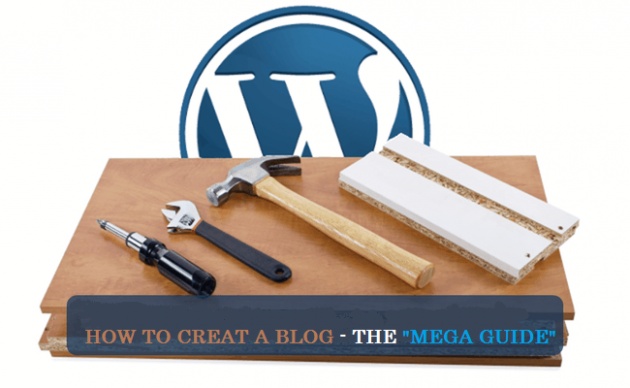
(source : google.es & edit by myself)
In this guide I have included absolutely everything you need to know from A to Z, to mount a good blog as things should be done in 2016.
Moreover, this guide is a key document in this blog and therefore is constantly improving and updating. To do this, your feedback, doubt and things you think I missed, etc., it will be enormously useful and more than welcome for me which you can do through the comments.
Creating a quick vs professional blog
Today, creating a blog is easy because we have different options to choose from:
- Quick and easy way
- Professional, but also a little more laborious.
We will see both options, you choose which one to go with.
If you want to use this guide to create a blog in 5 minutes, you can do it, just go to block creation of the blog, run the step No.5 you can see in the table of contents and you have your blog.
Contents Table
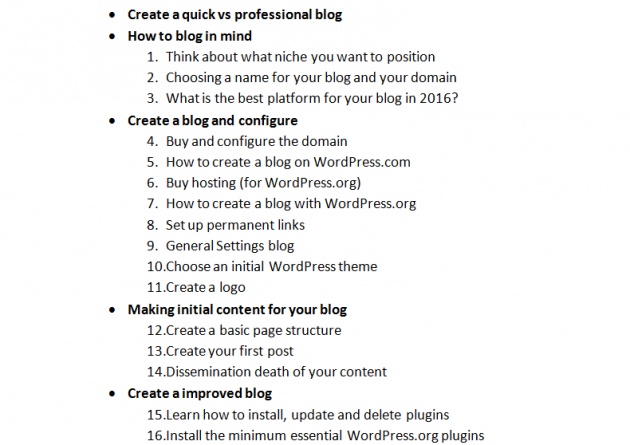
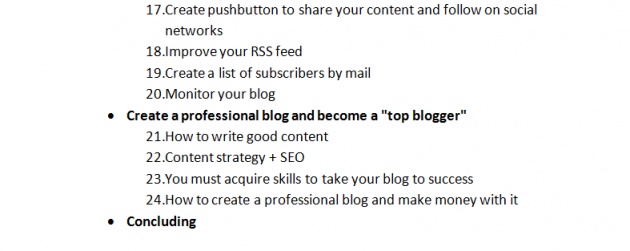
Create a blog in 5 minutes is perfect if you have little time, id you do not want to complicate things at the moment and want to see some initial results in the beginning.
However, I highly recommend not staying there. Believe me when I say that if that's the best effort you are willing to invest your draft blog will not get far.
How to blog in mind
With platforms like WordPress.com or Blogger, today, creating a blog is not a mystery, it is extremely easy to create a blog completely free and within less than 5 minutes.
But creating a blog that works is not a technical issue, but a matter of strategy and vision. It makes no sense to start a blog without setting a course.
Trust me: no one has 100% clear ideas at the beginning. But the message I want to convey is that you from day one keep thinking on what your blog's vision and goals are for you. From there it's okay to go a few days or even weeks a little stumbling, experimenting, etc. It is normal, even good if you take advantage well. But after a while you have to set the vision of your project, along with specific objectives.
Not doing so means investing many hours of effort in the blog which is not going anywhere and will not work, so the vast majority of beginners bloggers abandon, either they start realizing after many months of time and effort they have wasted by not taking some vital decisions before starting working on the blog. They have made the decision not to work with rigor in the vision of the project and have been stumbling all the way to abandon pro frustration and boredom in the absence of results.
So my advice: do not turn yourself into a failure and do your homework before creating the blog.
Lets see how this is done:
1. Think about what niche you want to position in
You can start a blog simply because you feel like doing it for personal satisfaction and you do not mind the readership or you can do it with a specific goal.
There are many possible objectives: to build a community of readers that interest to your content, boost your career, make extra income by monetizing it directly or indirectly or even build a platform one day be the backbone of your professional activity.
If you have a goal like this, the first thing is to clarify your ideas on the theme or topic of your blog and analyze the viability of your idea. This provides a complete post, but the basics of this analysis is to answer these questions:
- Is there really an audience interested in the subject? Do people perform searches of this? How big is your audience?
- How common is the niche? Are you able to differentiate it from other bloggers?
- What is the profile of the audience? What are their needs? What is their pain?
- How can you ease the pain? What is your contribution value?
Now you wonder how to answer these questions. Well, luckily there are tools (for free) to help you do it. For example Long Tail, SEO.
One more suggestion: This information is not an exact science, it is simply information that separates the wheat from the chaff and will helps to point you in the right direction.
2. Choosing a name for your blog and your domain
The choice of the name of your blog, along with your domain name is another key decision in the process of how to create a blog as it will have a profound impact on your blog.
It is a process that has much "art" and which I will now summarize the most important keys, but it deserves at least a post dedicated which I may write in future.
First, consider the following guidelines:
- Although it is obvious, remember the name of your blog and the name of your domain are closely related. If they can not be identical they seek at least the differences are the least possible.
- If you're serious, having your own domain is not optional. The cost is ridiculous (less than 10 € / year in places like, for example, Namecheap) and, instead, provides very important benefits, among others, is easier to remember, will convey a more professional image and can have addresses custom email.
- Do not rush in choosing these names. Being an important decision as it is, should ponder well because once you put everything in place under that name and has spent time, not easy to change your mind.
A problem that is likely you encounter is the difficulty of making that decision. Especially if you already have clear the concept and content of your blog, but do not just give the name (very typical situation), you will be slowed and perhaps even somewhat frustrated.
Strategies to choose your name
To find that perfect name, there are basically three different approaches:
- Personal name: an example would be yourname.con. This approach fits, especially in blogs where the main objective is to strengthen the personal mark of the author about an occupation. It is an approach that is doing very well in activities where the person is the main character as consulting services or activities lecturer.
- Brand Name: This is bit more for the brand, first because it is more sought of the "branding" of the site, create a brand and not link the site to both a specific person, and second, because being two that started this blog It makes incoherent direct linking to a specific personal brand. This does not mean that the blog is not used to develop a personal brand of both, but in this case does not fit the site name will linked to only one of the two.
- Name niche: This is a very "SEO" approach to capitalizing on the weight of keywords in a domain. It may be perfectly compatible with a brand. Taking into account the weight of the subjects blogging and WordPress, I could have titled my blog, for example, also "Blogs & WordPress" as, indeed, have done in blogsandwordpress.com. In this case, moreover, it would be quite natural brand name. But usually niche sites are more aggressive domain names, very oriented SEO and not very suitable as brand names, names like "compraraireacondicionado.com" "seguroscoche.com" or "regalosoriginales24.com".
Regarding the type of ownership, it is still advisable to get a .com domain, its image and because it seems that is still advantageous in terms of SEO, although not as much as in the past. In any case, you should know that SEO topics to be beyond the basic principles (such as the question of the weight they have keywords in a domain) are very elusive since these issues are changing as Google updated its algorithm.
Here is Youtube video which might be helpful in choosing your domain or blog name.
(source : youtube.com)
3. What is the best platform for your blog in 2016?
How could it be in other way, the issue of what is the best platform for a blog is a classic debate today is still active. So here I will just summarize very quickly the essential points of this issue, along with my personal opinion:
- I recommend using WordPress yes or yes. And therefore, this is the way to follow this guide. WordPress is the leading global platform with great distance with the following options and it is for something: for being extremely powerful, have tens of thousands of additional third-party products, however, it remains a free product.
- You have to know that there are two versions of WordPress with similar user interface. The simplified variant, WordPress.com, which despite being enough to start for most people, is significantly less potent than the variant "full-equipped" which is WordPress.org. In return, WordPress.com is a free cloud service (i.e, similar to a G-mail account) that lets you create a blog in less than 5 minutes by opening a simple user account. Otherwise, WordPress.org requires that you purchase your own hosting, unlike WordPress.com is not a single cloud service where you you sign up and go. Although the application of WordPress.org as such is free, the hosting does have a small monthly cost.
- Many people use Google Blogger as a alternative. It is a service similar to WordPress.com cloud, very good technically, but I personally do not recommend this option, especially for several reasons: First because it is Google and blogging does not belong to the "core" business of Google, with the risk of closure of this service.
Which of these options is best for you then?
Simply, the question is this: opt for one or another option is a matter of value in your particular case which compensates you more.
If you want speed and simplicity of implementation, use WordPress.com, but you must also assume their limitations.
If you want from the beginning the incredible power, flexibility and freedom offered by WordPress.org you, then you have to take some more effort for the implementation of WordPress.org, a small monthly economic cost due to hosting and linked to it also greater technical difficulty because you have to make not only the initial installation of WordPress, but also its maintenance.
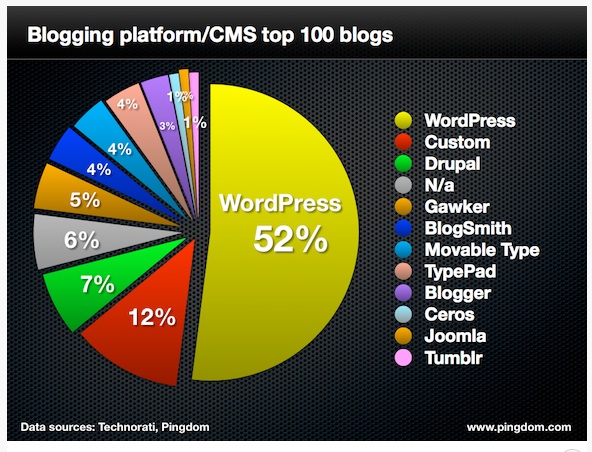
(source : google.es)
WordPress is king among professional blogs. In graph shows the distribution of 2013 according to data from Technorati.
In any case, every case is different and this decision is a matter of that they are full of variations and can not be addressed in four lines.
Create a blog and configure
At this point and taken the above decisions, you are ready to get down to work and create your blog, so let's move to the technical side of this issue.
4. Buy and configure the domain
As I mentioned above, if your blog is not a simple toy to tinker, but a "serious" project on that you really are going to spend regularly time, either purely personal, hobby, or professional, for the reasons above mentioned, we strongly recommend that you purchase your own domain, which is also something that comes very cheap.
The best option to buy a domain depends on the version of WordPress you use.
For simplicity I recommend that if you opt for WordPress.com, self-service use WordPress domains (about 13 € / year approx.). In the case of using WordPress.org you should hire, or in conjunction with your hosting service, or with a specialized provider names like Namecheap or GoDaddy domain.
The simplest option is to hire the domain along with the hosting, even if you manage many sites can be more interesting not to hire along with the hosting because suppliers specialized in domains are more complete management tools, slightly better prices and more comfortable if you change your hosting.
5. How to create a blog on WordPress.com
Now you definitely have everything you need to create your blog, so get to work.
In this section we will see WordPress.com. If you had chosen to WordPress.org, skip this step and go directly to the next step: Step 6.
Creating a free blog at WordPress.com is a really simple process, just follow the steps in the following video and 5 minutes you will have your operating blog:
(source : youtube.com)
6. Buy hosting (only for WordPress.org)
In case you want to use WordPress.org you will also need a server hosting for your blog. I will recommend two options with I work on my projects and for which you will have special discounts for being my readers:
- If you want to quicken the maximum price, but without giving up a quality hosting and a good support, Hostgator.
- If you want more value than a plain hosting, Webempresa. It's really a premium hosting very affordable. Its main front Hostgator advantages are the quality of its servers (make rapid site), WordPress technical support, service backup every 4 hours.
If you prefer to contrast other options, make sure you have enough knowledge to choose your provider judiciously because the hosting provider is critical to your project.
7. How to create a blog with WordPress.org
Purchased the hosting, you are ready to create a professional blog with WordPress.org that is more complex because in this case is no longer a simple cloud service in which to open a user account, but you have to download the WordPress application (which is free) and install it yourself in your hosting server.
But do not panic, create a blog with WordPress.org is also nothing to write home and in the following video explains in detail how to create a blog with hosting. The video was made using Hostgator, also serves to Webempresa hostings since both use the same management tool: cPanel, the reference in its sector. Click on the link given below the picture to watch video.
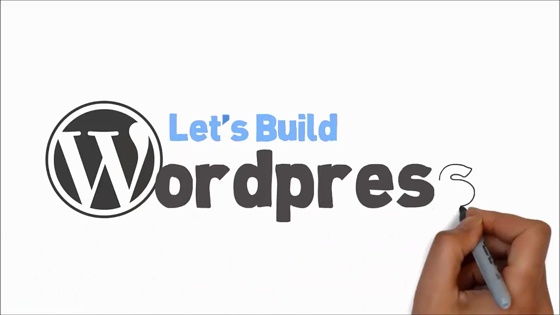
(source : google.es)
How To Install WordPress on Hostgator (Web Hosting)
8. Set up permanent links
If there is one crucial thing in WordPress settings I want to highlight more than everything else, it is to make sure you use the permanent links (permalinks) they are "pretty". For this reason I have differentiated this section from the general configuration which comes next.
In WordPress.com there is no problem, in this version of WordPress permalinks are already set as default and can not be changed, but WordPress.org, the default option remains the parameterised URLs, which I don't understand for frankly reasons.
So my recommendation is very simple: in the menu "Settings -> Permalinks" the WordPress admin panel, change the default as indicated by "Default" to "Name Input". See in the picture shared below.
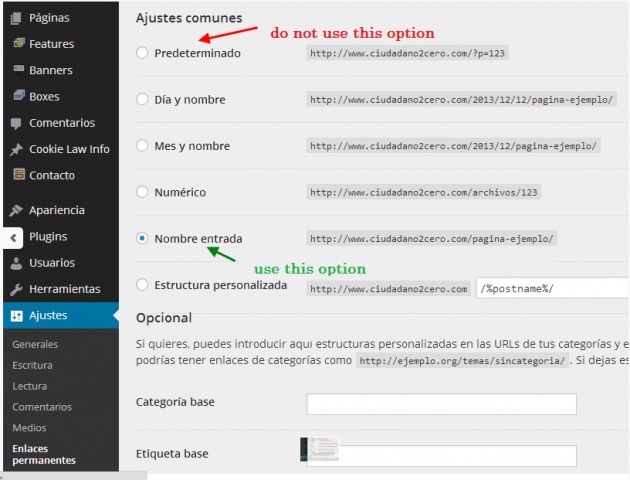
(source : ciudadno2cero.com)
Configure permalinks is one of the most important in a newly installed WordPress.org.
9. General blog settings
In the video (click here to watch the video) you can see how this is done, along with the rest of settings that I recommend for your newly installed blog.
The video is made with WordPress.org, but the process would be identical in configuration WordPress.com except permanent links in this version of WordPress are pre-configured as permanent links.
And as part of global configuration, do not forget to create a gravatar. Here you can trivially create and associate a photo to one or more e-mail addresses you specify at discharge.
Create a gravatar is essential if you are a blogger. Click here to create. As a result, in the comments on your own blog and when you comment on others, a picture of you and not a ugly generic avatar, appears as you have seen in the comments sections of blogs. I highly recommend this by the benefit as a blogger.
10. Choose an initial WordPress theme
The ease of radically changing the design of WordPress through a simple "plug & play" mechanism as are the issues is one of the key factors that have made this platform in the huge success that it is today. With a change of subject will change immediately the look of your blog at all levels: the general layout, colors, fonts, etc., etc., etc.
At first you will not have a mature idea how to choose the perfect theme, and it will be after a few months, a year or more, when your blog has consolidated minimal. It is then that can really be worth investing a little more effort in selecting your topic and invest money in a subject.
11. Create a logo
The minimum essential customization with any blog should have a logo. A good logo makes magic and even a very simple and minimalist, thanks to a good logo topic, can cause a fully professional printing.
At first you do not need a very professional logo. If you are not capable of creating a logo by yourself don't worry, you have two very good options to create a logo very easily and quickly: Fiverr and 99Designs.
There may be cases where the importance of the logo is somewhat less, such as blogs very oriented to a personal brand, since here the photo of the person in question can supply in a way the function of the logo, but still most these blogs also have their logo (usually the same name, but with a logo design).
Making initial content for your blog
Right now your blog is ready to run. At this point the most important thing is to give life to "take a walk" or which is the same: to create the first content.
12. Create a basic page structure
Personally, my suggestion would be to create before the first posts the basic pages. I refer to those pages that every blog should have: pages how "About" in which you present yourself and your blog or contact page where people will be able to send an email through a form.
If you notice, here's the main difference between WordPress posts and pages: the pages are a fixed content frame make the site and kept in the same place long. The posts are dynamic content that is continuously publishing.
A good structure of this type, with good content, although very simple, it will cause a better impression to the reader that conveys a sense of a blog created with more affection and seriousness. In addition, unlike a good design, it is quite affordable for anyone other than a trained professional.
13. Create your first post
As I said earlier, in my opinion, apart from a basic structure of pages, you should have at least 4-5 posts of very good quality for the day you post your blog.
In writing your content I feel obliged to learn the basic principles of copywriting. The most important thing will be able to write good titles, titles that will attract attention and motivate the reader to click to discover the contents of the post.
14. Dissemination of your content
I do not think you will be surprised if I tell you it costs a lot to get the initial traffic to the blog. As much you do an excellent SEO for your posts, google virtually ignores you during the first 2 or 3 months and you will have to earn every click of your readers freehand.
Fortunately, they have invented social networks are one of the best allies you can have a beginner blogger for dissemination of its contents. So in these first months of life of your blog you should spend a good part of your time to actively promote your content in them.
Well, this is not so complicated. You can get it if you work hard a bit and your contents is good. Even +100 visitors a day is not an unreasonable figure if your theme and quality of your content have enough potential, and strive to apply the techniques discussed here.
And now you will understand even better why at this stage will not be time for such useless things like messing with WordPress themes ...
This is the 1st part of my blog post, 2nd part is still under process and will be published as soon as I complete. Thanks for reading, do comments if you like and if you think I am missing something please let me know. Take care, Googdbye..!
-Toshi



